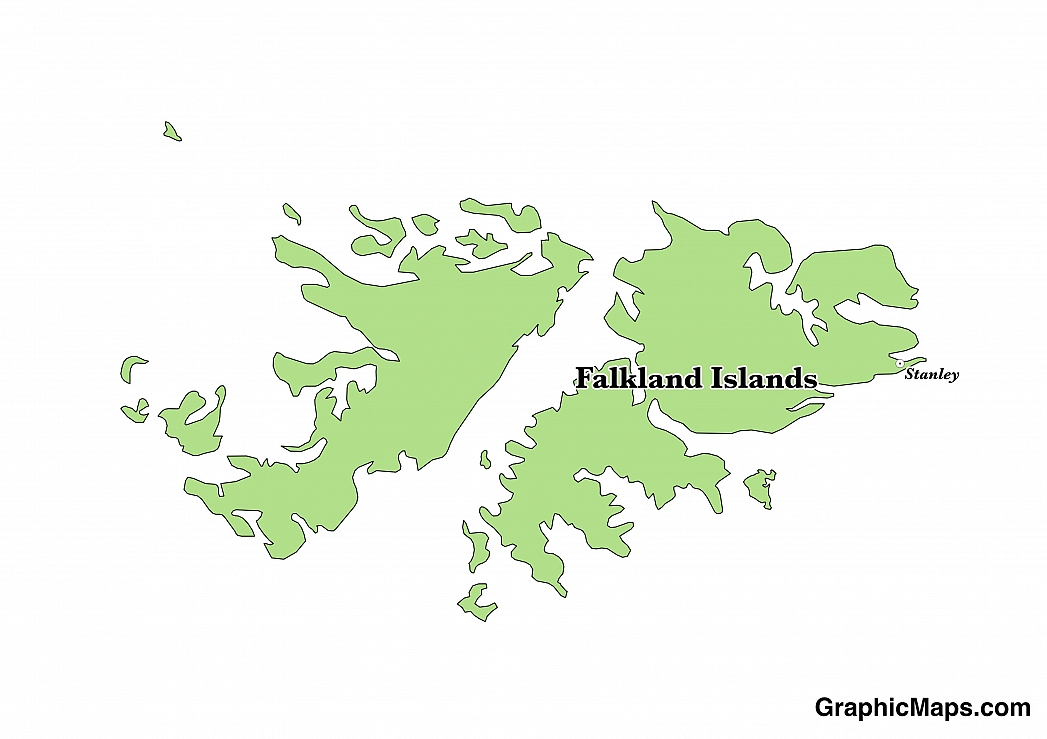Where is Falkland Islands?
Located in Southern South America, Falkland Islands is an island nation. It has a 1,288.00 km coastline. The United Kingdom continues to reject Argentina's requests for soverignty talks.
Stanley is the capital city of the Falkland Islands. Also referred to as Port Stanley, it is located on the East Falkland Island. It was officially recognized as the capital City of the Falkland Islands when it was selected as the most suitable port on the island. In 2012, a census that was conducted in the Falkland Islands revealed that the territory had a total population of 2,841. Of the total population, about 2,121 are in Stanley. Therefore, Stanley hosts over three-quarters of the territory’s total population. Stanley is a top tourist destination in the Falkland Islands. Tourism is a top job creator in the city. Most of the tourists get into the city through the sea. It is common for tourists to outnumber the locals in the city. The most common places of interest that attract most tourists are the Gypsy Cove and Cape Pembroke. The climate of Stanley can be described as a subpolar oceanic climate. The temperatures of the city are usually low most of the time. The average rainfall received in the city is approximately 544 mm per annum. The possible sunshine received in the city per annum is 36.5%.
Read more on Falkland Islands's CapitalFalkland Islands is a South American country covering 12,173.00 km2. The area includes the two main islands of East and West Falkland and about 200 small islands. and slightly smaller than Connecticut. Its geographic coordinates are 51 45 S, 59 00 W and Stanley is the capital city.
The archipelago takes its name from the Falklan Sound.
Its ISO code is FK.
Geography
Falkland Islands has a mean elevation of 0 m above sea level.
It has a cold, rainy marine climate with occasional snow. Its terrain is mostly rocky, with some plain coverage.
Population
Falkland Islands has a population of 2,931 making it the 229th largest in the world. Most residents live in and around the town of Stanley.
English is the most widely spoken language. The major ethnic groups reported are Falkland Islander, British, St. Helenian and Chilean. The majority of the population is Christian, with a significant minority being non-religious.
English is the official language of the Falkland Islands. It is the language used in day to day activities. English is an Indo-European language falling under the West Germanic family of languages. It has 26 letters in its alphabet, 21 consonants and 5 vowels and uses Latin script in its writing. Approximately 91% of the inhabitants of Falkland Islands can fluently communicate in English. The remaining minority who cannot fluently converse in English are mostly immigrants from non-English speaking countries such as Asia and South America. English is used in both official and casual contexts. The English spoken in Falkland Island is British in nature. However, due to its isolation, the English in the island has evolved to be slightly different from the British English. The dialect developed is referred to as Falkland Island English. The accent of Falkland Island English tends to be stronger amongst the rural dwellers. Besides English, there are minority languages spoken by the minority people in the territory. The dominant minority language in the country is Spanish. Approximately 10% of the inhabitants of Falkland Island speak Spanish.
Read more on Falkland Islands's LanguagesThe dialing code for the country is 500.
Government
It is an overseas territory of the United Kingdom. Its constitution was last ratified in 2009.
The Falkland Islands are a constitutional monarchy and a parliamentary democratic territory of Britain. The official residence of the appointed governor is referred to as the Government House. The construction of the Government House in Stanley was completed in 1845. The Queen's official residence, The Buckingham Palace, is located in London. The parliament of Falkland Islands is unicameral. It is composed of 8 elected members. The monarch, who is the Queen of Britain is often absent in the Falkland Islands. In her absence, there is usually a governor appointed to represent her. The governor is, therefore, the head of the independent territory. A Chief Executive is also appointed to serve as the head of Government. Elections are held to elect eight members to the Legislative Assembly. Five members represent Stanley and three members represent the Camp.
Read more on Falkland Islands's GovernmentEconomy
The currency of Falkland Islands is the Pound (FKP).
Its major imports include fuel, food and drink, and building materials.
Flag
The flag of the Falkland Islands consists of defaced British Blue Ensign with the Union Jack at the top corner of the hoist side and the Islands’ coat of arm on the fly side. The coat of arm consists of a ram on a tussock grass and the Desire ship beneath. The island’s motto, “Desire the Right,” is at the bottom of the shield. The flag is in the proportion of 1:2 and was adopted on January 25, 1999. The flag of Falkland Islands symbolizes its association with Britain, being one of Britain’s overseas territories. The blue Ensign has been used since 1876 and has only been defaced with different seal designs. Some of the arms used depicted the HMS Hebe, a vessel that was used by the British to access the islands, a bullock, and a white disc.
Read more on Falkland Islands's FlagThis page was last modified on January 17th, 2018
More on Graphicmaps

Published on 2019-11-06
What is a Trade Embargo?

Published on 2019-11-04
Which Two Countries Used to Have the Same Flag?

Published on 2019-09-16
What Is the Only Two-Sided State Flag?

Published on 2019-09-16
Which Country Flag Looks Like the Texas Flag?

Published on 2019-08-29
Flags That Resemble the US Flag

Published on 2019-08-20
